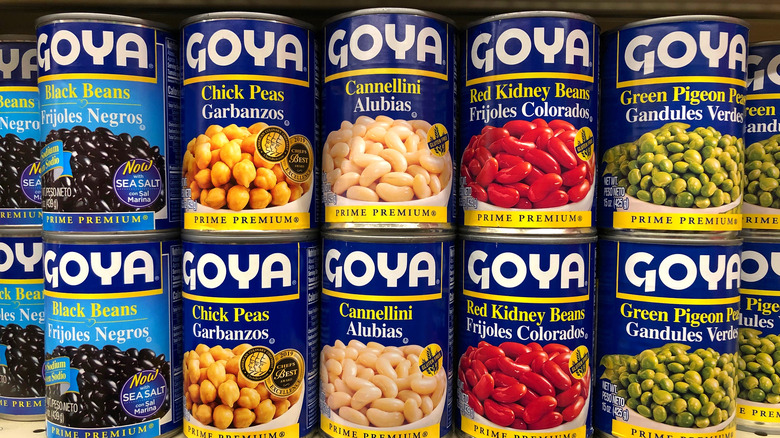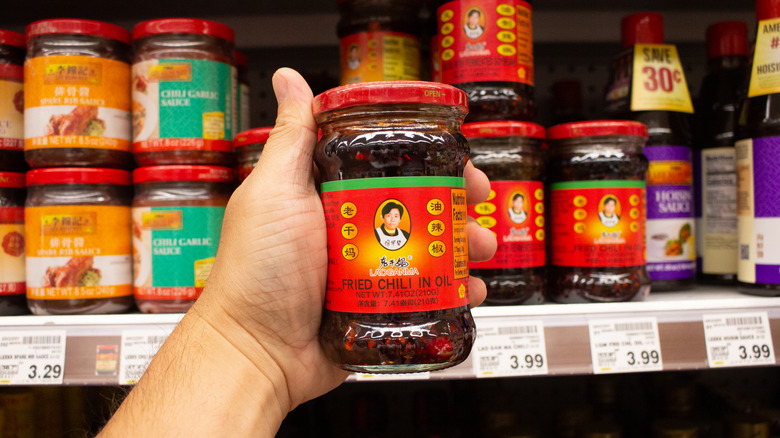Why David Chang Hates The Ethnic Aisle In Grocery Stores
When you hear "ethnic aisle," you probably picture that one aisle at your local grocery store that predominantly features foods from Latin America and Asia. But have you ever stopped to consider why it's called the ethnic aisle and what exactly that means? Speaking on his podcast "The David Chang Show," Momofuku chef David Chang gave listeners his thoughts on the issue, calling ethnic aisles "the last bastion of racism that you can see in full daylight in retail America."
Soon after, in an interview with The Washington Post, Chang clarified his position, saying, "Italian products that were once marginalized, such as olive oils and vinegars, are now routinely integrated into grocery store aisles, while Chinese, Japanese and Latino foods remain stuck in their own sections." He added that he believed these aisles were a holdover from the 1950s, when Asian Americans faced significant prejudice following World War II. And he's not the only one calling out the term. Restaurant critic Soleil Ho told Mother Jones, "The imprecision of the word — and the assumption that it doesn't apply equally to people and cuisines associated with Europe or white America — gives me such a headache."
How the cuisine of whole cultures is set apart with one word
To understand Chang's position, it helps to understand the meaning of the term "ethnic," which the Merriam-Webster dictionary defines as "a member of an ethnic group; especially: a member of a minority group who retains the customs, language, or social views of the group." By designating an aisle as "ethnic" and only stocking specific foods there, stores are unwittingly segregating types of food specifically from certain cultures. Critics say the ethnic aisle others certain — usually nonwhite — groups by keeping their foods, often Asian and Latin American, separate from what is seen as otherwise "ordinary" cuisine, whether they're iconic dishes invented in America or the foods of other, predominantly white, nations. Moreover, in most culinary circles, the word "ethnic" has already been left behind as an outdated term. Knowing this, it's not hard to see why Chang and many others dislike the ethnic aisle.
To many, it seems strange to relegate the flavors of so many cultures to a single tiny aisle, especially in a country where nearly 40% of the population is nonwhite. However, it helps to understand how the ethnic aisle came to be in the first place. In the 1950s, stores began creating space for more international products following a push from distributors looking to sell foods outside the American norm. Additionally, there was an increased interest in global cuisine from service members who traveled during WWII. During this period, the ethnic aisle was explicitly geared toward white Americans and featured "exotic" options that were a bit of a novelty — like Italian food.
Is the ethnic aisle biased, convenient, or both?
Since then, America has made plenty of progress. But the argument around the ethnic aisle also draws questions about racism versus convenience. In 2021, The New York Times interviewed several individuals who shared different opinions. Chitra Agrawal, founder of Indian condiment company Brooklyn Delhi, describes how her foods have sold the best in ethnic aisles because that's where customers know to go for Indian cuisine. However, she disagrees with the aisle's premise. On the other hand, a self-described "basic 55-year-old white lady" shopper named Jolene Tolbert stated that the contents of the aisle were "a wonderland" for finding ingredients she otherwise might never have known to try. She goes on to say that if they were incorporated into other aisles, it would "make shopping a lot more difficult."
So while the aisle itself is ostracizing to predominately nonwhite cuisines, as Agrawal points out, it's how consumers have been trained to shop. If you're making chicken adobado street tacos or some crispy Thai basil beef, the ethnic aisle is the place to go. That's how it's been since the '50s, and it is, technically, convenient. But Chang and many others still contend that its convenience doesn't outweigh the racist connotations.


